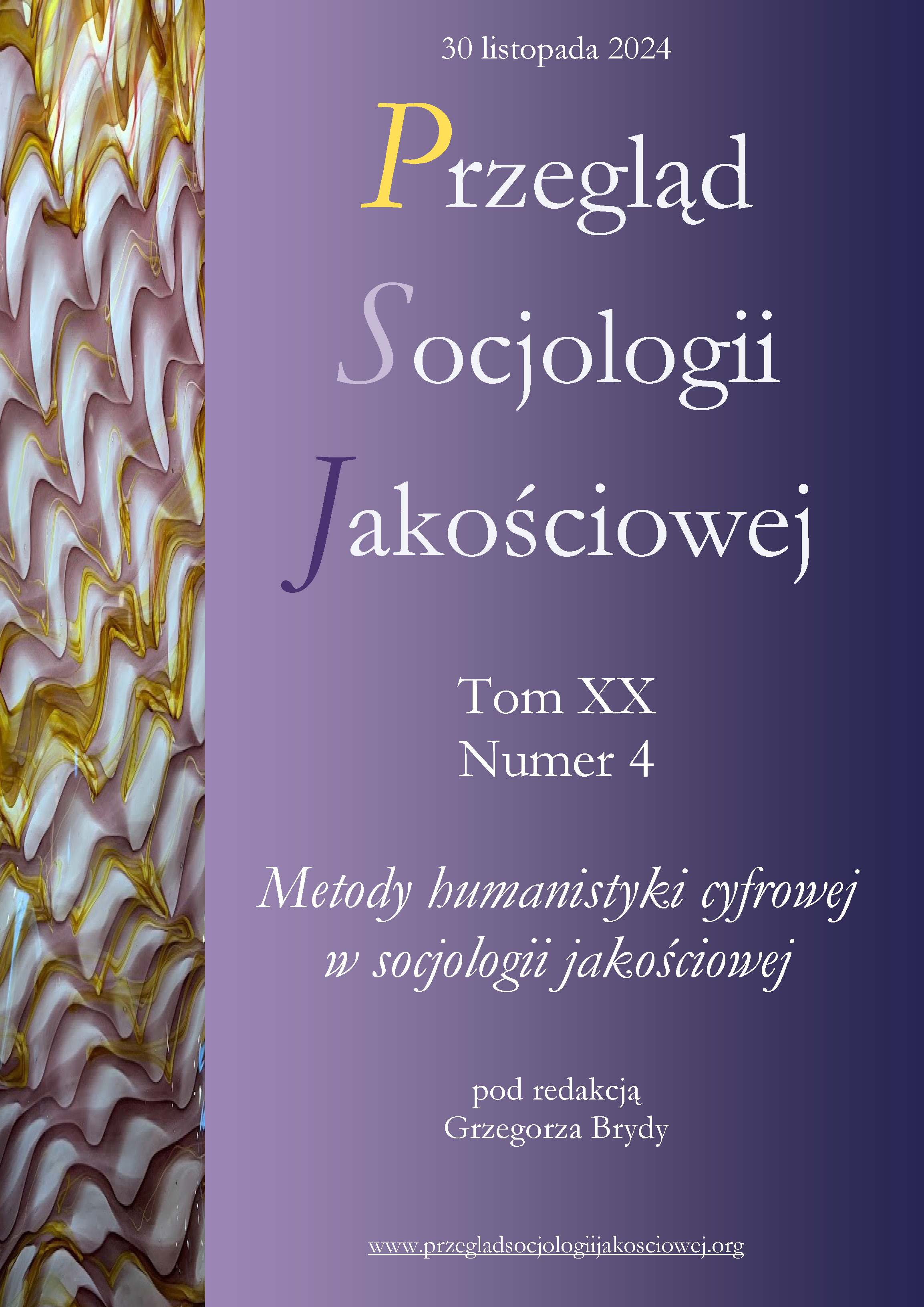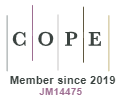Najdłuższa wiosna w historii. Sposoby interpretowania przemian na granicy polsko-niemieckiej w przeddzień jej zamknięcia
DOI:
https://doi.org/10.18778/1733-8069.20.4.07Słowa kluczowe:
bordering, współpraca polsko-niemiecka, obszary transgraniczne, przemiany społeczno-przestrzenne, COVID-19Abstrakt
Artykuł dotyczy rozmywania i odtwarzania granicy polsko-niemieckiej, zwłaszcza sposobów, w jakie tak zwani eksperci codzienności interpretowali te procesy w 2018 roku. Badania realizowano w rejonie Słubic i Gubina (oraz na przyległych obszarach wiejskich) z użyciem indywidualnych wywiadów pogłębionych, analiza danych inspirowana była zaś teorią ugruntowaną. Zdaniem osób badanych różnice kulturowe, prawne i ekonomiczne w sposób istotny określały doświadczenia i interakcje na pograniczu, mimo osłabienia fizycznych granic. Analiza sposobów interpretowania procesów deborderingu i reborderingu umożliwia także lepsze zrozumienie charakterystyk narracji, które kształtowały myślenie o przeobrażeniach danego regionu w badanym okresie oraz ich znaczenia dla procesów integracji i wyłaniania się obszarów transgranicznych. W dyskusji autor argumentuje za przeorientowaniem współczesnych badań nad pograniczem polsko-niemieckim, kładąc nacisk na studiowanie procesu odtwarzania się granicy oraz towarzyszących mu narracji i podkreślając, w jaki sposób owe interpretacje współkształtować mogą przebieg przyszłych zdarzeń, jak to się stało w przypadku zamknięcia granic na skutek pandemii COVID-19.
Pobrania
Bibliografia
Asher Andrew D. (2012), Inventing a city: cultural citizenship in ‘Słubfurt’, “Social Identities: Journal for the Study of Race, Nation and Culture”, vol. 8(5), pp. 497–520, https://doi.org/10.1080/13504630.2012.667601
Google Scholar
DOI: https://doi.org/10.1080/13504630.2012.667601
Berger Peter, Luckmann Thomas (1983), Społeczne tworzenie rzeczywistości, translated by Józef Niżnik, Warszawa: Państwowy Instytut Wydawniczy.
Google Scholar
Brandariz José A., Fernández-Bessa Cristina (2021), Coronavirus and Immigration Detention in Europe: The Short Summer of Abolitionism?, “Social Sciences”, vol. 10(6), 226, https://doi.org/10.3390/socsci10060226
Google Scholar
DOI: https://doi.org/10.3390/socsci10060226
Christmann Gabriela B. (2010), Kommunikative Raumkonstruktionen als (Proto)Governance, [w:] Kilper Hiederose (ed.), Governance und Raum, Baden-Baden: Nomos, pp. 27–48.
Google Scholar
DOI: https://doi.org/10.5771/9783845226255-25
Dębicki Marcin, Doliński Wojciech (2013), Sympatia i „ciepła obojętność” jako kategorie analityczne stosunku zgorzelczan do mieszkańców Görlitz, „Opuscula Sociologica”, vol. 2, pp. 7–30.
Google Scholar
Dolińska Kamila, Makaro Julita (2020), O rodzeniu się wielokulturowości z transgraniczem w tle. Na przykładzie pandemii COVID-19 (i jej skutków) w miastach podzielonych, “Przegląd Zachodni”, vol. 4(377), pp. 225–244.
Google Scholar
Dolińska Kamila, Niedźwiecka-Iwańczak Natalia (2017), German Neighbours from Across the River – Insiders? Strangers? Others?, “Sociální studia/Social Studies”, vol. 14(1), pp. 94–116, https://doi.org/10.5817/SOC2017-1-95
Google Scholar
DOI: https://doi.org/10.5817/SOC2017-1-95
Dolińska Kamila, Makaro Julita, Niedźwiecka-Iwańczak Natalia (2018), Cud pogranicza? Zgorzelczanie, gubinianie i słubiczanie o życiu w miastach podzielonych, Warszawa: Nomos.
Google Scholar
Dolińska Kamila, Niedźwiecka-Iwańczak Natalia, Makaro Julita (2017), Divided towns in the Polish-German borderland in the perspective of the transborder processes (transnational/horizontal Europeanisation?) – opportunities and threats, [in:] Zbigniew Kurcz, Elżbieta Opiłowska, Jochen Roose (eds.), Advances in European Borderlands Studies, Wrocław: Nomos, pp. 211–238.
Google Scholar
DOI: https://doi.org/10.5771/9783845276892-211
Dołzbłasz Sylwia, Zelek Krzysztof (2019), Wybrane cechy zagospodarowania przestrzennego i aktywności gospodarczej w otoczeniu miejsc przekraczania granicy polsko-niemieckiej, “Przegląd Geograficzny”, vol. 91(4), pp. 487–510, https://doi.org/10.7163/PrzG.2019.4.3
Google Scholar
DOI: https://doi.org/10.7163/PrzG.2019.4.3
Eigmüller Monika (2006), Der duale Charakter der Grenze. Bedingungen einer aktuellen Grenztheorie, [in:] Monika Eigmüller, Georg Vobruba (eds.), Grenzsoziologie. Die politische Strukturierung des Raumes, Wiesbaden: VS Verlag für Sozialwissenschaften, pp. 55–74.
Google Scholar
DOI: https://doi.org/10.1007/978-3-531-90245-6_5
Frymark Kamil (2023), Germany: a major drop in the number of illegal migrants crossing the Polish border, Ośrodek Studiów Wschodnich, https://www.osw.waw.pl/en/publikacje/analyses/2023-11-28/germany-a-major-drop-number-illegal-migrants-crossing-polish-border [accessed: 10.03.2024].
Google Scholar
Galasiński Dariusz, Meinhof Ulrike H. (2002), Looking across the river: German-Polish border communities and the construction of the Other, “Identity Politics”, vol. 1(1), pp. 23–58, https://doi.org/10.1075/jlp.1.1.05gal
Google Scholar
DOI: https://doi.org/10.1075/jlp.1.1.05gal
Gibbs Graham (2011), Analizowanie danych jakościowych, translated by Maja Brzozowska-Brywczyńska, Warszawa: Wydawnictwo Naukowe PWN.
Google Scholar
Hennig Anja (2021), The spatial dimension of coronavirus crisis management and the role of subnational actors in the German-Polish border region, “European Societies”, vol. 23, pp. 859–871, https://doi.org/10.1080/14616696.2020.1846065
Google Scholar
DOI: https://doi.org/10.1080/14616696.2020.1846065
Herzog Lawrence A., Sohn Christophe (2019), The co-mingling of bordering dynamics in the San Diego–Tijuana cross-border metropolis, “Territory, Politics, Governance”, vol. 7(2), pp. 177–199, https://doi.org/10.1080/21622671.2017.1323003
Google Scholar
DOI: https://doi.org/10.1080/21622671.2017.1323003
Jańczak Jarosław (2018), Symmetries, asymmetries and cross-border cooperation on the German–Polish border. Towards a new model of (de)bordering, “Documents d’Anàlisi Geogràfica”, vol. 64(3), pp. 509–527, https://doi.org/10.5565/rev/dag.518
Google Scholar
DOI: https://doi.org/10.5565/rev/dag.518
Jańczak Jarosław (2020), Re-bordering in the EU under Covid-19 in the First Half of 2020: A Lesson for Northeast Asia?, “Eurasia Border Review”, vol. 11, pp. 2–16, https://doi.org/10.14943/ebr.11.2
Google Scholar
Keller Reiner (2013), Kommunikative Konstruktion und diskursive Konstruktion, [w:] Reiner Keller, Hubert Knoblauch, Jo Reichertz (eds.), Kommunikativer Konstruktivismus. Theoretische und empirische Arbeiten zu einem neuen wissenssoziologischen Ansatz, Wiesbaden: Springer, pp. 69–94.
Google Scholar
DOI: https://doi.org/10.1007/978-3-531-19797-5_4
Keller Reiner, Knoblauch Hubert, Reichertz Jo (eds.) (2013), Kommunikativer Konstruktivismus. Theoretische und empirische Arbeiten zu einem neuen wissenssoziologischen Ansatz, Wiesbaden: Springer.
Google Scholar
DOI: https://doi.org/10.1007/978-3-531-19797-5
Knoblauch Hubert (2017), Die kommunikative Konstruktion der Wirklichkeit, Wiesbaden: Springer.
Google Scholar
DOI: https://doi.org/10.1007/978-3-658-15218-5
Kolossov Vladimir, Scott James (2013), Selected conceptual issues in border studies, “Belgian Journal of Geography”, vol. 1, https://doi.org/10.4000/belgeo.10532
Google Scholar
DOI: https://doi.org/10.4000/belgeo.10532
Konrad Victor (2015), Toward a Theory of Borders in Motion, “Journal of Borderlands Studies”, vol. 30(1), pp. 1–17, https://doi.org/10.1080/08865655.2015.1008387
Google Scholar
DOI: https://doi.org/10.1080/08865655.2015.1008387
Kurzwelly Michael, Stefański Tomasz (2022), Nowa Amerika, Poznań: Galeria Miejska Arsenał.
Google Scholar
Löfgren Orvar (2008), Regionauts: the Transformation of Cross-Border Regions in Scandinavia, “European Urban and Regional Studies”, vol. 15(3), pp. 195–209, https://doi.org/10.1177/0969776408090418
Google Scholar
DOI: https://doi.org/10.1177/0969776408090418
Malinowski Piotr (2021), Przez Polskę do Niemiec. Czy uchodźcy będą odsyłani nad Wisłę?, “Krytyka Polityczna”, https://krytykapolityczna.pl/swiat/ue/malinowski-przez-polske-do-niemiec-czyuchodzcy-beda-odsylani-nad-wisle/ [accessed: 10.03.2024].
Google Scholar
Marody Mirosława (ed.) (2021), Wartości w działaniu, Warszawa: Scholar.
Google Scholar
McCall Cathal (2012), Debordering and Rebordering the United Kingdom, [in:] Thomas M. Wilson, Hastings Donnan (eds.), A Companion to Border Studies, Chichester: John Wiley & Sons, Ltd., pp. 214–229.
Google Scholar
DOI: https://doi.org/10.1002/9781118255223.ch12
Opiłowska Elżbieta (2020), The Covid-19 crisis: the end of a borderless Europe?, “European Societies”, vol. 23, pp. 589–600, https://doi.org/10.1080/14616696.2020.1833065
Google Scholar
DOI: https://doi.org/10.1080/14616696.2020.1833065
Opiłowska Elżbiera, Dolińska Kamila, Kajta Justyna, Makaro Julita, Niedźwiecka-Iwańczuk Natalia (2022), Narracje o miastach podzielonych w Europie Środkowej: Słubice i Frankfurt nad Odrą oraz Cieszyn i Český Těšín, Warszawa: Scholar.
Google Scholar
Pap Norbert, Reményi Péter (2017), Re-bordering of the Hungarian South: Geopolitics of the Hungarian border fence, “Hungarian Geographical Bulletin”, vol. 66(3), pp. 235–250.
Google Scholar
DOI: https://doi.org/10.15201/hungeobull.66.3.4
Pries Ludger (2007), Integration als Raumentwicklung – Soziale Räume als Identifikationsräume, [in:] Petra Deger, Robert Hettlage (eds.), Der europäische Raum. Die Konstruktion europäischer Grenzen, Wiesbaden: Springer, pp. 123–144.
Google Scholar
DOI: https://doi.org/10.1007/978-3-531-90246-3_7
Rogowski Łukasz, Frąckowiak Maciej (2023), COVID-19’S re-bordering impact on the identity of the Polish-German borderland from the perspective of Polish residents: the case of the twin cities of Słubice and Gubin, “Ruch Prawniczy, Ekonomiczny i Socjologiczny”, vol. LXXXV(3), pp. 119–143, https://doi.org/10.14746/rpeis.2023.85.3.09
Google Scholar
DOI: https://doi.org/10.14746/rpeis.2023.85.3.09
Roose Jochen (2010), Vergesellschaftung an Europas Binnengrenzen. Eine vergleichende Studie zu den Bedingungen sozialer Integration, Wiesbaden: Springer.
Google Scholar
DOI: https://doi.org/10.1007/978-3-531-92227-0
Sandberg Marie (2016), Restructuring locality: practice, identity and place-making on the German-Polish border, “Identities”, vol. 23(1), pp. 66–83, https://doi.org/10.1080/1070289X.2015.1016523
Google Scholar
DOI: https://doi.org/10.1080/1070289X.2015.1016523
Stokłosa Katarzyna (2014), The Border in the Narratives of the Inhabitants of the German-Polish Border Region, [in:] Katarzyna Stokłosa, Gerhard Besier (eds.), European Border Regions in Comparison, New York: Routledge, pp. 257–274.
Google Scholar
DOI: https://doi.org/10.4324/9781315815602
Strauss Anselm L., Corbin Juliet M. (1990), Basics of qualitative research: grounded theory procedures and techniques, Thousand Oaks: Sage Publictions.
Google Scholar
Więckowski Marek, Timothy Dallen J. (2021), Tourism and an evolving international boundary: Bordering, debordering and rebordering on Usedom Island, Poland-Germany, “Journal of Destination Marketing & Management”, vol. 22, 100647, https://doi.org/10.1016/j.jdmm.2021.100647
Google Scholar
DOI: https://doi.org/10.1016/j.jdmm.2021.100647
Wilson Dean, Weber Leanne (2008), Risk and Preemption on the Australian Border, “Surveillance and Society”, vol. 5, pp. 124–141.
Google Scholar
DOI: https://doi.org/10.24908/ss.v5i2.3431
Pobrania
Opublikowane
Wersje
- 2024-11-30 - (2)
- 2024-11-30 - (1)
Jak cytować
Numer
Dział
Licencja

Utwór dostępny jest na licencji Creative Commons Uznanie autorstwa – Użycie niekomercyjne – Bez utworów zależnych 4.0 Międzynarodowe.
Funding data
-
Narodowe Centrum Nauki
Grant numbers MO-2016/23/G/HS6/04021














